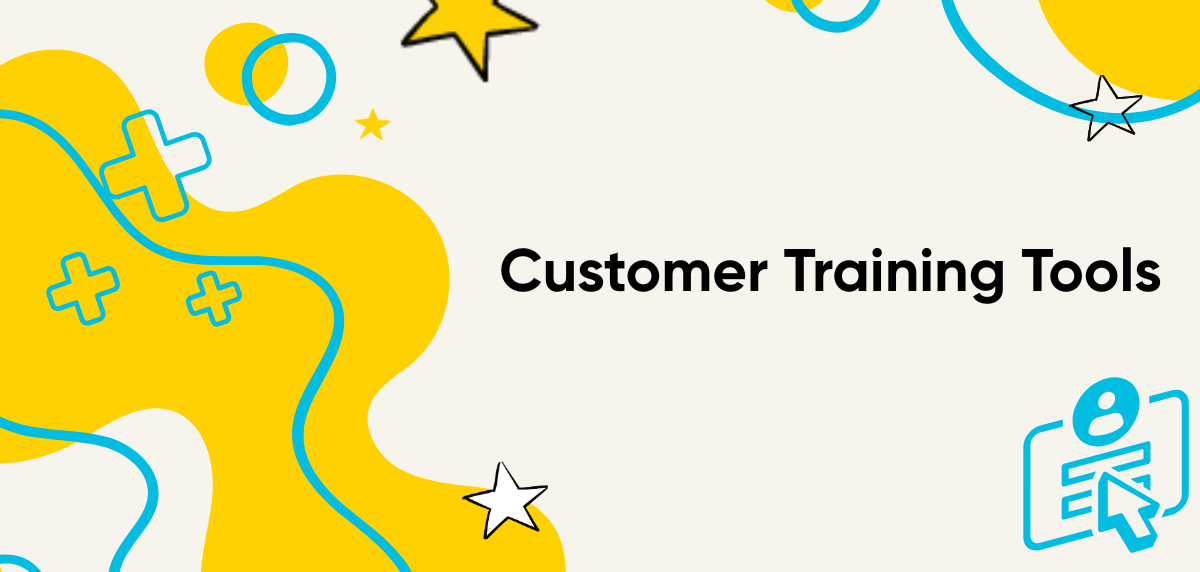Recently updated on April 24th, 2025
We’ve compiled 22 of the best customer training tools on the market which will help turn your customers into product experts, help you reduce churn, and grow your revenue.
To enjoy these benefits you’ll typically need, a well-thought out customer training strategy, and the following software:
- An elearning authoring tool
- Video creation and editing software
- A virtual training/webinar platform
- Customer onboarding software
- A learning management system
- A knowledge base platform
- Survey tools & more
Let’s dive in 👇
Interactive Elearning Authoring Tools
Elearning authoring tools are there to help you create interactive customer training experiences. You can use them to create onboarding training, product courses, quizzes, assessments, and much more.
1. Arlo Training Software
Arlo Training Software is an all-in-one training platform for creating, scheduling, and delivering in person, virtual, blended and elearning training.
Arlo’s inbuilt elearning authoring tool is designed to enable you to rapidly create professional elearning content from simple prompts or by transforming existing materials.
You can see a quick-fire demo of how Arlo’s elearning features work below 👇
The platform allows for creating various online content types (quizzes, assignments, videos, scenarios, microlearning) and delivering them as standalone modules or integrated parts of larger courses. As well as providing a responsive learner experience accessible on any device for self-paced learning.
Beyond content creation and delivery, Arlo aims to manage the entire learner journey. This includes publishing courses to a website, automating administrative tasks (scheduling, registration, payments, communications, certificates), providing a branded self-service learner portal, offering robust reporting and analytics
Customer Training Use Cases
Structured Customer Onboarding Programs: Combine self-paced eLearning modules (created quickly using the AI builder) covering product basics with scheduled live webinars or Q&A sessions managed within Arlo’s scheduling system.
Self-Service Product Knowledge Base: Build and host a library of standalone online modules (microlearning, video tutorials, scenario-based examples) on various product features or use cases, accessible to customers anytime via the branded portal.
Pre-Requisite Training for Advanced Sessions: Assign foundational eLearning modules (like pre-reading or introductory concepts) that customers must complete in their own time before attending more advanced live training or consultation sessions.
Automated Training Delivery & Certification: Set up online courses that customers can register for (potentially with payment processing), complete self-paced modules, take quizzes/assignments, and automatically receive certificates upon successful completion.
Rapid Deployment of Training on New Features: Use the AI-powered tools to quickly generate or update training modules when new product features are released, ensuring customers have timely access to relevant information.
Supplementing Live Customer Training: Add online resources like videos, quizzes, or interactive assignments to existing instructor-led customer workshops to create a richer blended learning experience.
You can sign-up for early access of Arlo’s elearning authoring tool, and kick-start your customer training below 👇
Want to be first in line to try Arlo’s new elearning authoring features? Sign up for early access!
We’ll be in touch with details for early access as we get closer to launch. You’ll be contacted first!
2. Articulate Storyline 360
G2 Score:
Overview
Articulate Storyline 360 is a powerful, Windows-based desktop application or creating highly customized and interactive eLearning courses.
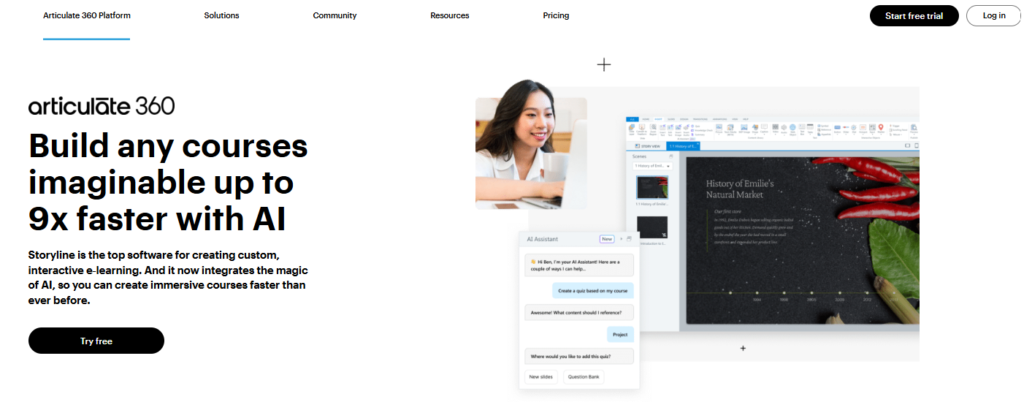
It’s part of the larger Articulate 360 subscription suite, which includes other tools and resources like Rise 360 (web-based authoring), Content Library 360 (assets), and Review 360 (collaboration).
Storyline offers immense flexibility through slide layers, states, triggers, and variables, allowing developers to build complex interactions, simulations, and branching scenarios without needing deep coding knowledge.
It supports various output formats (HTML5, SCORM, xAPI, AICC) for compatibility with Learning Management Systems (LMS).
Customer Training Use Cases
Interactive Product Onboarding: Creating step-by-step, guided walkthroughs of software or product features where customers can click and interact within a simulated environment.
Scenario-Based Training: Developing branching scenarios to teach customers best practices, troubleshooting techniques, or how to achieve specific outcomes using the product.
Certification Programs: Building comprehensive courses with assessments and tracking capabilities for formal customer certification on product proficiency.
3. Adobe Captivate
G2 Score:
Overview
Adobe Captivate is another desktop-based eLearning authoring tool available for both Windows and macOS.
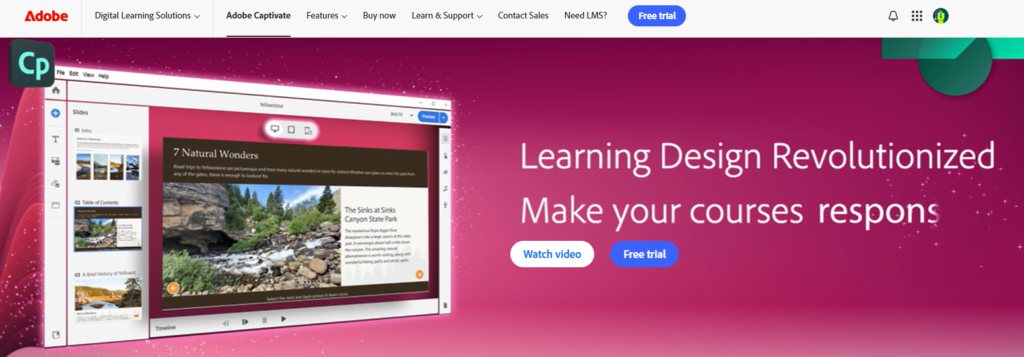
It’s known for its strong capabilities in creating software simulations (with smart capture technology) and responsive eLearning projects that adapt to different screen sizes.
Captivate also offers features for Virtual Reality (VR) project creation, PowerPoint conversion, and integration with assets from the Adobe ecosystem.
It supports various publishing standards (HTML5, SCORM, xAPI, AICC) and offers options for creating accessible content.
Customer Training Use Cases:
Detailed Software Demonstrations & Practice: Excels at capturing screen actions to automatically create demonstration, practice, and assessment modes for software training.
Responsive Mobile Training: Developing training modules on product usage that customers can easily access and view correctly on phones and tablets.
Virtual Reality Product Tours: Creating immersive VR experiences to showcase physical products, equipment, or environments (e.g., a virtual tour of how a machine works).
Converting Existing Presentations: Importing PowerPoint slides as a starting point for more interactive customer training modules.
4. iSpring Suite
G2 Rating
Overview
iSpring Suite is an eLearning authoring toolkit that functions as a PowerPoint add-in for Windows.
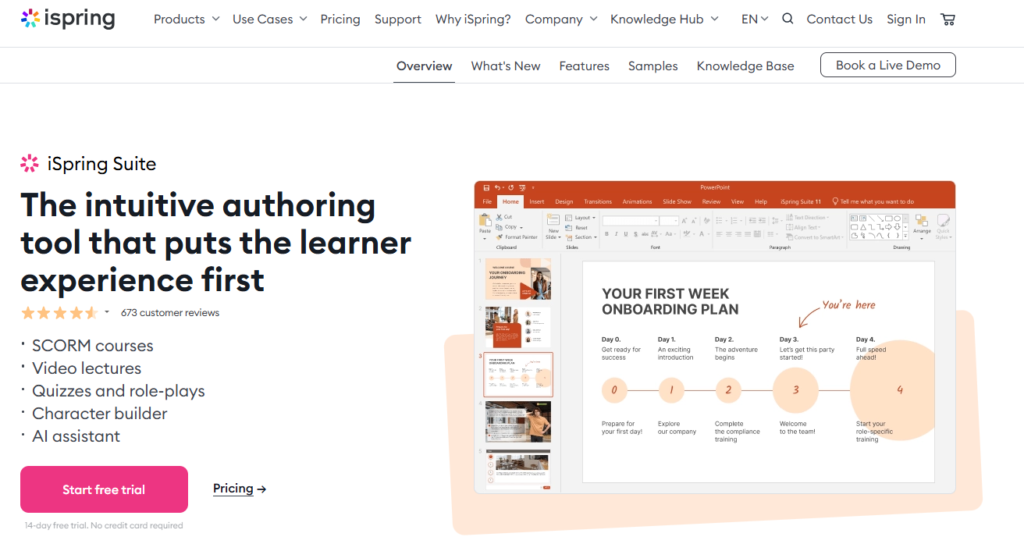
Its main strength lies in its ease of use, especially for those already familiar with PowerPoint. It allows you to improve any existing or new presentations with quizzes, interactions, dialogue simulations, screen recordings, and video/audio narration directly within the familiar PowerPoint interface.
It then converts the presentation into web-ready formats (HTML5, SCORM, xAPI, AICC). The iSpring Suite Max version includes a content library and collaboration tools.
Customer Training Use Cases:
Rapid Onboarding Content: Quickly converting existing marketing or product presentations into basic, trackable onboarding courses for new customers.
Simple “How-To” Guides: Easily creating straightforward tutorials for common product tasks or features, leveraging PowerPoint skills.
Knowledge Checks & Quizzes: Adding simple quizzes and surveys to presentations to reinforce learning about product features or policies.
Video Creation and Editing Tools:
You can use video creation and editing tools to create on-demand product videos, demos, troubleshooting guides and much more.
5. Camtasia
G2 Rating:
Overview
Camtasia is a user-friendly, desktop-based software (available for Windows and macOS) specializing in screen recording and video editing. It’s highly regarded for its ease of use, making it accessible for non-professional video editors.
It combines high-quality screen capture capabilities with a straightforward timeline editor, pre-built assets, annotations, callouts, transitions, and basic quizzing features. It’s ideal for creating tutorial-style content quickly and efficiently.
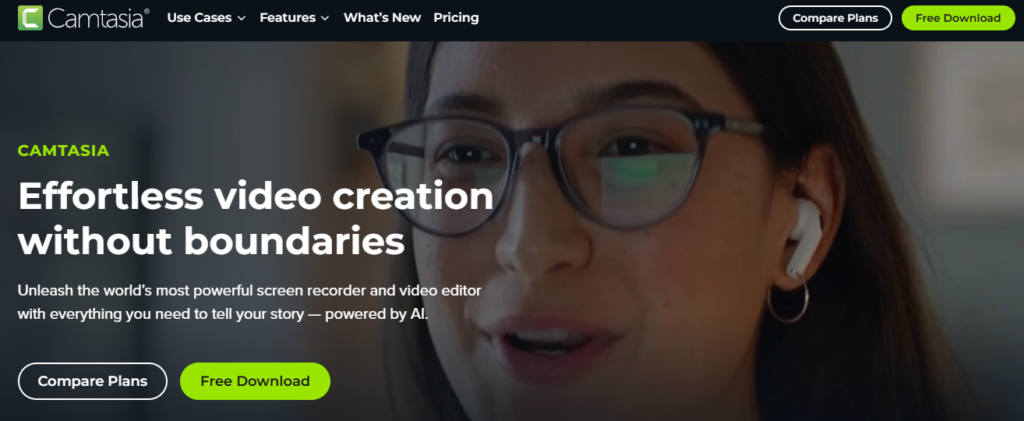
Types of Customer Training Videos Camtasia Can Create:
Screen Recording Tutorials: Clear, step-by-step videos showing customers how to use software features or navigate websites.
Software Demonstration Videos: Walkthroughs highlighting product functionality and workflows.
How-To & Troubleshooting Guides: Specific, task-focused videos guiding customers through processes or solutions to common problems.
Onboarding Welcome Videos: Simple, often screen-based, videos introducing new customers to a platform or service.
Feature Update Announcements: Quickly produced videos explaining new features or changes.
6. Adobe Premiere Pro
G2 Score:
Overview
Adobe Premiere Pro is an industry-standard, professional-grade non-linear video editing software (NLE) available for Windows and macOS as part of the Adobe Creative Cloud subscription.
It offers a vast, powerful toolset for complex editing, sophisticated visual effects (often integrated with After Effects), advanced color correction and grading, multi-camera editing, and comprehensive audio mixing.
It has a steeper learning curve than Camtasia but provides immense creative control for high-quality productions.
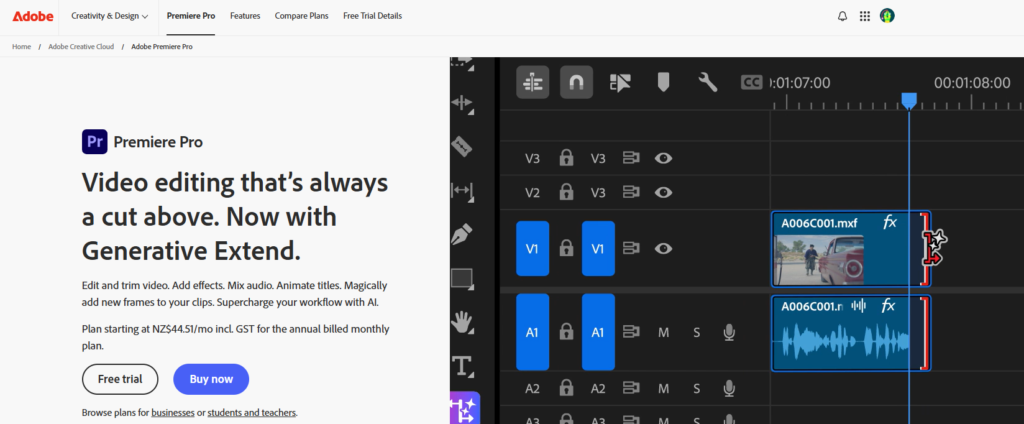
Types of Customer Training Videos Adobe Premiere Pro Can Create:
High-Production Value Product Overviews: Polished, often marketing-style videos introducing a product, service, or brand philosophy for customer education.
Customer Testimonial & Case Study Videos: Professionally edited interviews and footage showcasing customer success stories as learning examples.
Advanced Explainer Videos: Complex videos requiring intricate editing, motion graphics, or integration of diverse media types to explain difficult concepts.
Professionally Edited Live Training Footage: Transforming recordings from live customer events or workshops into high-quality, engaging on-demand video assets.
7. Animoto
G2 Score:
Objective
Animoto is a web-based video creation platform designed for extreme ease of use, primarily focused on creating short, engaging videos quickly, often for social media and marketing.
It comes with pre-designed templates, drag-and-drop functionality, and extensive libraries of licensed stock photos, video clips, and music.
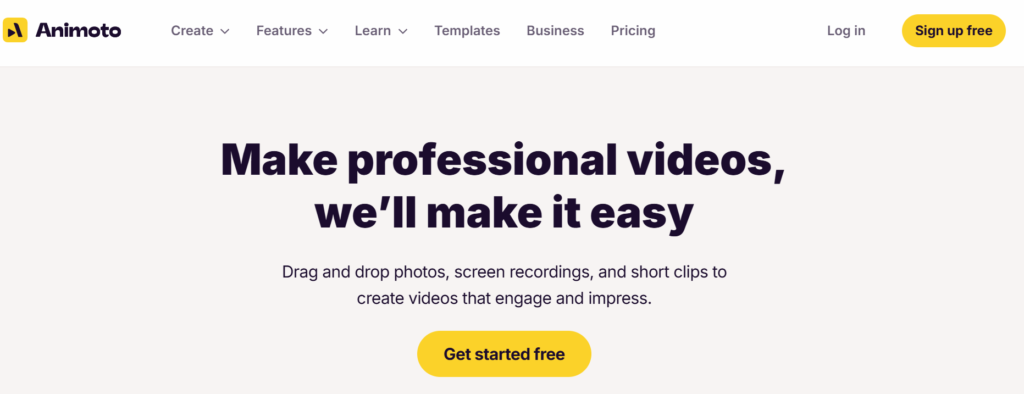
Types of Customer Training Videos Animoto Can Create:
Quick Feature Snippets: Short, template-based videos highlighting a single new feature or benefit.
Promotional Training Videos: Creating eye-catching videos announcing upcoming customer webinars, workshops, or new training resources.
Simple How-To Tips (using templates): Creating visually appealing, short tips or best practices using stock media and text overlays.
Product Benefit Summaries: Slideshow-style videos combining images, short clips, and text to explain the value proposition relevant to customer needs.
8. Loom
G2 Score
Objective
Loom is a video communication platform designed for quickly and easily recording screen activity, camera footage, or both simultaneously.
Available as a desktop application (Mac/Windows) and Chrome extension, its primary focus is on asynchronous communication – replacing lengthy emails, text messages, or unnecessary meetings with shareable video messages.
Loom is speedy and easy to use. Recordings are instantly available via a shareable link upon completion. It includes features like basic trimming, automatic transcription, viewer comments and reactions, calls-to-action within the video, and viewing analytics.
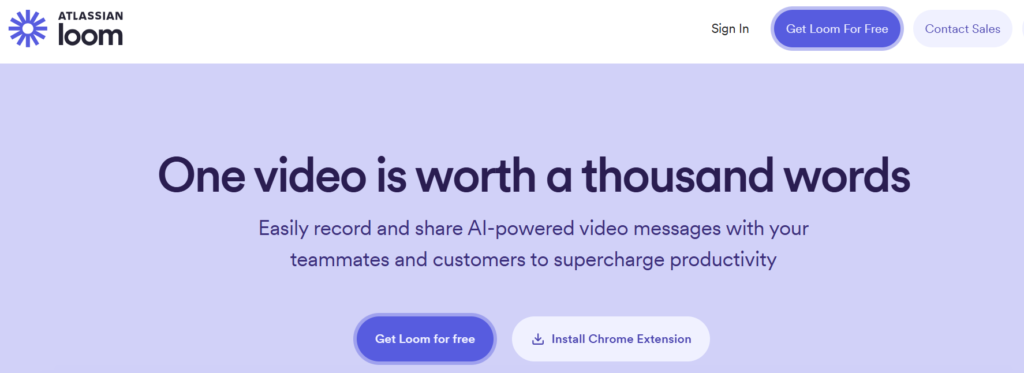
Types of Customer Training Videos Loom Can Create:
Personalized Troubleshooting/Support Videos: Recording a quick, custom video showing a specific customer exactly how to resolve their issue or use a feature they’re struggling with.
Quick “How-To” Snippets: Creating short, informal videos demonstrating a single task, workflow, or feature, easily shared via link in support tickets, emails, or chat.
Informal Feature Walkthroughs: Providing brief tours of new features or specific parts of a product, often less polished but faster to produce than fully edited videos.
Visual Answers to FAQs: Recording standard video answers to frequently asked customer questions to provide a clearer explanation than text alone.
Onboarding Nudges & Quick Tips: Sending short, friendly video messages guiding new users through key initial steps or highlighting useful tips shortly after they sign up.
Webinar and Virtual Training Platforms:
Webinar and virtual training platforms can be used to create live online customer training, as well as recording webinars that can be accessed on-demand by customers.
9. Zoom Webinars
G2 Score
Overview
Zoom Webinars is designed for broadcasting presentations or sessions to a large audience (from dozens to thousands of attendees).
Unlike standard Zoom Meetings where everyone can potentially participate equally, Webinars have distinct roles: hosts, co-hosts, panelists (who can share video, audio, and screen), and attendees (who primarily view and listen).
Attendees typically interact through controlled channels like Q&A, chat (if enabled), and polls. Webinars are well-suited for single-session events like large-scale training presentations, product announcements, or marketing lead generation.
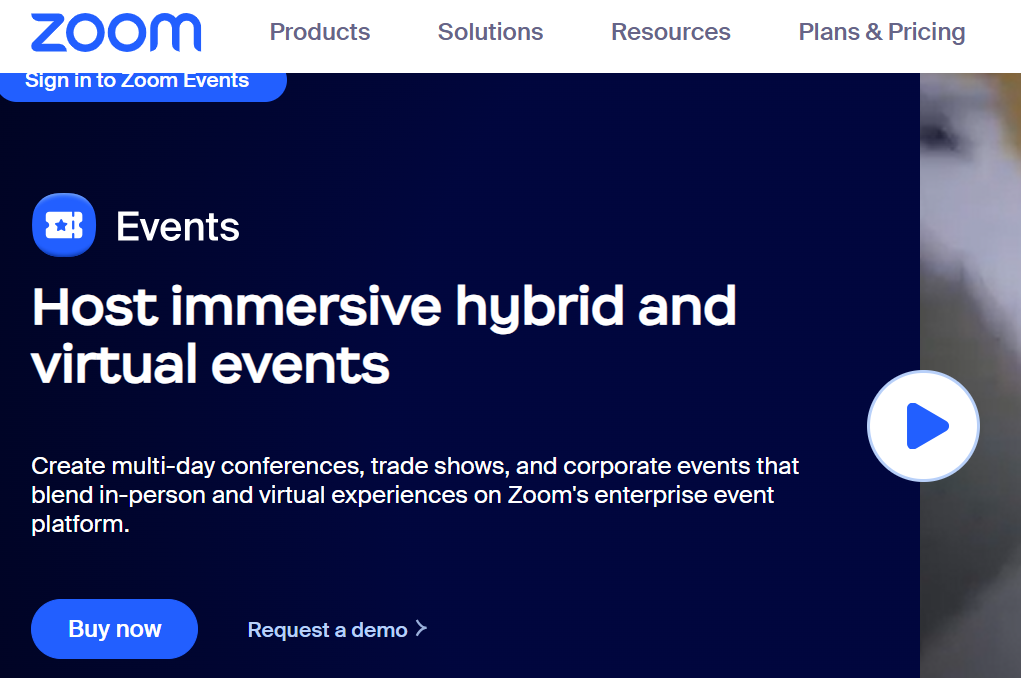
Key Features for Customer Training
Screen Sharing: Essential for demonstrating software, walking through presentations, or showing product interfaces live.
Q&A Management: Allows customers to submit questions formally, which trainers can answer live or via text, often with moderation capabilities to keep things organized.
Polling: Engage the audience, check comprehension during the training, or gather instant feedback on specific topics.
Chat Controls: Manage participant interaction – enable open chat, disable it, or allow chat only with hosts/panelists to minimize distractions during focused training.
Registration Management: Set up custom registration pages to gather customer details, track sign-ups, and send automated confirmation/reminder emails.
Recording & On-Demand Access: Record training sessions (cloud or local) so customers can review them later or catch up if they missed the live event.
10. GoToWebinar
G2 Score
Overview
GoToWebinar is another well-established webinar, and video conferencing platform specifically designed for hosting online presentations, workshops, and large-scale virtual events.
As part of the GoTo suite of business communication tools, it focuses on enabling organizations to deliver webinars reliably to audiences ranging from small groups to thousands of attendees. It provides presenters with tools for screen sharing, presentations, and audience engagement, while attendees typically join in a view/listen mode with controlled interaction methods.
GoTo Webinar emphasizes features around registration management, audience interaction (polls, Q&A, surveys), automated email communications, analytics, and integrations with other business systems like CRMs and marketing automation platforms.
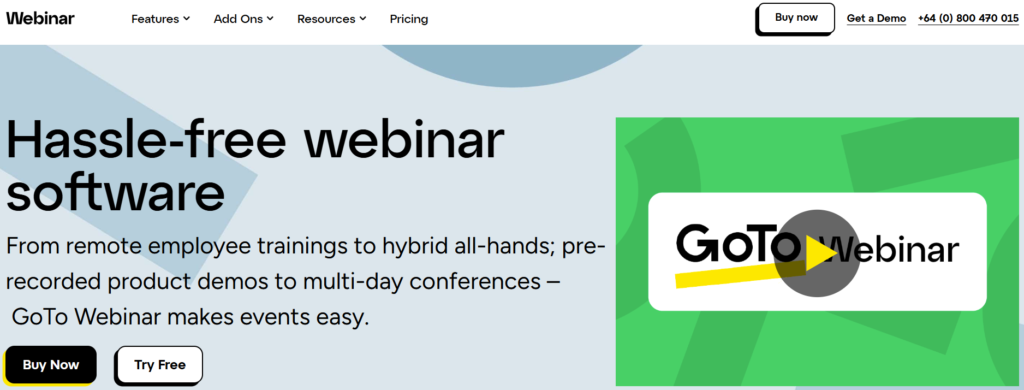
Key Features for Customer Training
Screen Sharing & Drawing Tools: Essential for delivering presentations, demonstrating software live, and using annotation tools to highlight specific areas on the screen for clarity.
Audience Engagement Tools:
- Polls: Launch instant polls to check customer understanding, gauge opinions, or simply keep the audience engaged during the training.
- Q&A: A dedicated module for attendees to submit questions, which trainers can manage, prioritize, and answer either verbally or via text.
- Surveys: Create and distribute surveys at the end of the training session to gather valuable feedback on the content, delivery, and effectiveness.
- Hand Raising: Allows attendees to signal attention non-disruptively if the trainer wants to take live verbal questions.
Registration Management: Set up customizable registration pages to capture relevant customer information and track who signs up for training sessions.
Recording Capabilities: Record the entire training session (including screen sharing and audio) for customers who couldn’t attend live or for attendees to review later. Recordings can often be stored online or downloaded.
Reporting and Analytics: Generate detailed reports on registrants, attendees, attendance duration, attentiveness metrics (if applicable), and engagement (poll responses, questions asked, survey results) to measure the impact and reach of the training.
Onboarding and Guided Tour Tools:
Onboarding and guided tour tools help you improve customer onboarding, feature announcements, and get real-time data and feedback on how your customers are using your product.
11. WalkMe
G2 Score
Overview
WalkMe is a leading digital adoption platform designed to improve user onboarding, adoption, and the ability to use a product within the context of web based applications and software platforms.
The tool provides real-time, contextual guidance using overlays, tooltips, and interactive walkthroughs layered on top of the live software interface – with the ultimate goal of helping users get value from software without needing to leave the app for help.
Other cool features include the ability to create onboarding task lists for users, analytics and behavioral insights to see exactly how users are interacting with a platform and much more.
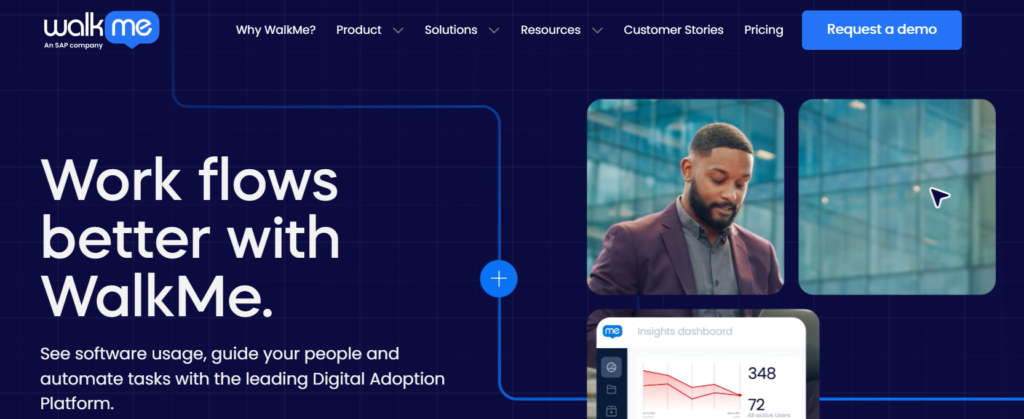
Key Features and Uses for Customer Training
Interactive In-App Onboarding: Set up workflows, product tours and first steps to help your customers start seeing value in your product at the earliest opportunity.
Contextual Feature Training & Adoption: Introduce customers to new or underutilized features relevant to their tasks using targeted walkthroughs and tips.
Real-Time Process Guidance & Compliance: Set-up customers to follow specific workflows or complete critical tasks correctly by guiding them step-by-step within the live application.
In-App Communication & Announcements: Use shout outs to alert customer directly within the application about new updates such as upcoming webinars, knowledge base articles or new feature releases.
Collecting Contextual Feedback: Deploy in-app surveys triggered by specific actions or events to gather immediate feedback about a feature or the effectiveness of the guidance you’ve provided.
12. UserGuiding
G2 Score
Overview
UserGuiding is another digital adoption platform designed to help a business’s customers onboard, learn about new features, and get access to support. You can build product tours, tooltips, checklists and help centers that layer on top o f the live application.
The platform also comes with a no-code/lowcode editor for ease of use, and to allow non-technical teams like customer success or product to announce and deploy guidance to customers quickly.

Key Features and Uses for Customer Training
Interactive Onboarding Tours: Easily set-up guides to walk new customer through your products essential features and initial set-up of your application
In-App Feature Announcements & Training: Announce new features and product updates using In-App Messages and link directly to your knowledge base articles to help customers use a particular feature.
Collect Feedback for Training Improvement: Use built-in NP surveys or feedback modules to gather customer feedback and input
Segmented Training Delivery: Target specific resources such as guides, checklists or messages to differing customer segments based on things such as their subscription plan, language, level of access or user role.
A Customer Training LMS
Customer training LMS platforms can be used to create and sell customer training programs.
13. LearnWorlds
G2 Review
Overview
LearnWorlds is a multi-purpose LMS used by businesses, creators, and entrepreneurs to create, market and sell online courses.

It’s well known for its high degree of customization, and white-labeling capabilities which give businesses the opportunity to create a fully branded learning environment using their own domain.
Key features include an interactive video-editor where you can add questions, overlays and links. An assessment engine supporting various quiz types, assignments and certificates, and built-in website builder for building course storefronts.
Uses for Customer Training
Build a Dedicated Customer Training Portal Create a fully-branded portal where customers can access your training courses, resources, and community features.
Develop Comprehensive Product Courses: Use the native course builder to structure multi-module courses covering topics from basic onboarding to advanced product usage, incorporating various content types such as video, text and downloadable resources.
Assess Customer Knowledge & Skills: Design quizzes, exams and assignments using the assessment engine to test customer understanding and proficiency of different topics.
14. Skilljar
G2 Review
Overview
Skilljar is an LMS specifically built to deliver customer education. Key features for doing this include course and learning path creation, supporting various content types such as video, SCORM, PDFs, quizzes and the ability to integrate live sessions.
It also includes native certification management, the ability to create a customizable and branded learning portal, and ecommerce functionality for selling courses.
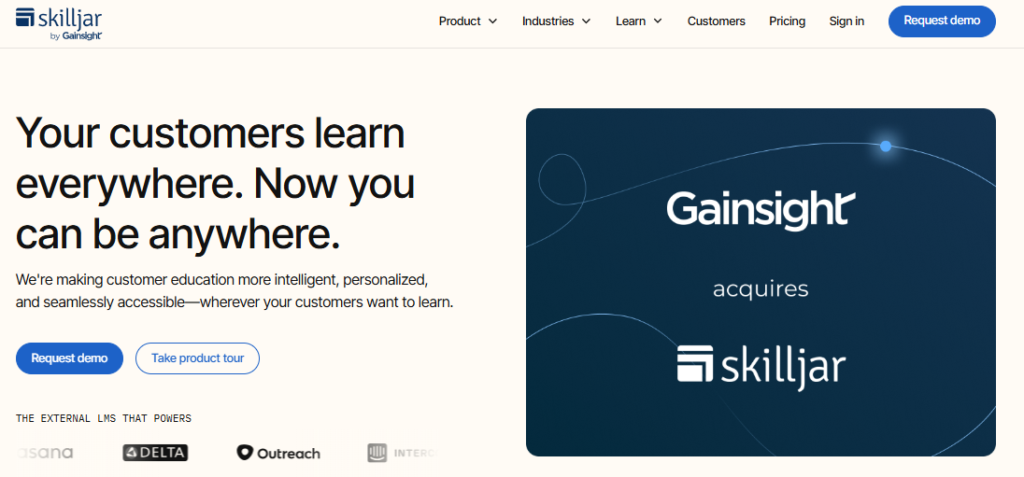
Key Features and Uses for Customer Training
Delivering Customer Training from a Branded Portal: Build a branded portal that acts as a central hub for all of your customer training content, courses and certification programs.
Deliver Scalable Onboarding Programs: Create structured onboarding for new customers and guide them through essential training modules.
Set-up Robust Certification Programs: Design, implement and manage formal customer certification programs, including setting pre-requisites, delivering exams, and automatically issuing brand certificates and renewals.
Knowledge Base & Documentation Tools:
As the name suggests, knowledge base tools are what you use to create your help and support articles, FAQs and walk through guides. They are often the first kind of tool you’ll use if you’re starting a brand new customer training program.
15. Document360
G2 Score
Overview
Document360 is a knowledge base platform you can use to create, manage, publish and analyze self-service knowledge bases you provide your customers with.
Key features include rich editors (supporting WYSIWIG and Markdown), category management for organizing content, version control and rollback capabilities, built-in workflows for content review and publishing ana detailed analytics you can use to track article views, search queries, user feedback and more.
Key Features and Uses for Customer Training
Creating Comprehensive Customer Knowledge Bases: The core use of the platform is the building and hosting of searchable customer knowledge bases containing how-to articles, FAQs, videos, and best practice documentation.
Features to Support Customer Onboarding: Easily create a structured, easy to use knowledge base that serves as a key resource for onboarding new customers
Analytics to Help Identify Knowledge Gaps: Monitor analytics to see which resources customers find the most value in, what they are searching for unsuccessfully, and where articles need improvement based on direct customer feedback.
Localization Features for Local Support: Content offered in multiple-languages to support a global customer base.
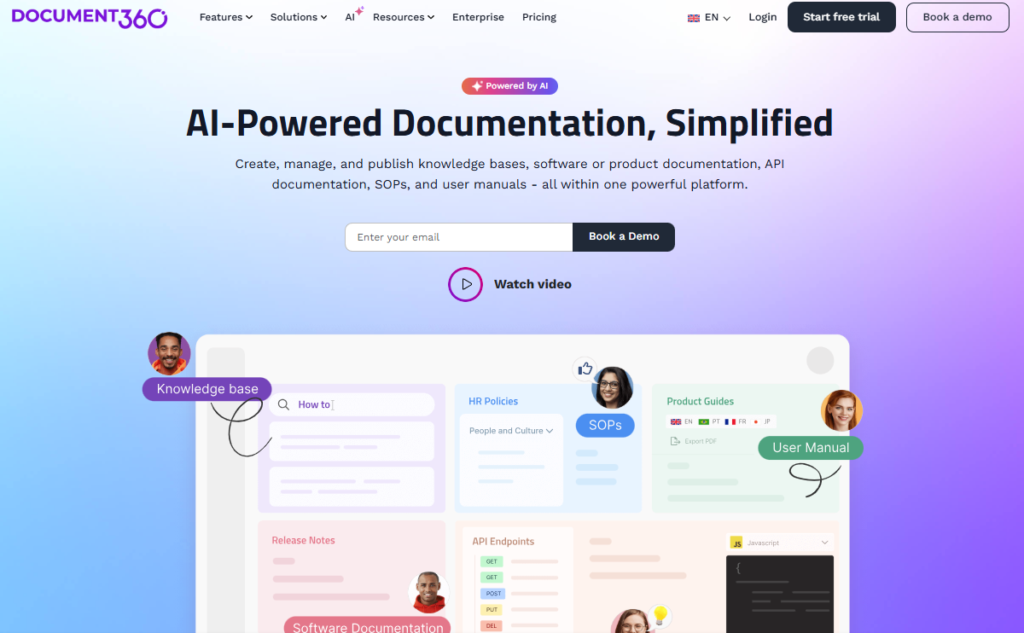
Survey & Feedback Tools:
Survey tools are used to get pre and post training feedback from your customers. They are simple to use, relatively inexpensive and come with basic analytics tools to help you analyze the feedback you receive,
16. SurveyMonkey
G2 Score
Overview
SurveyMonkey is a well-known online surveying tool which can be used to create, distribute and analyze surveys. You can use it to create and send pre and post course surveys to customers to gather their feedback.
It’s easy to use, and a cost-effective tool to keep tabs on the effectiveness, and feelings of your customers about the training programs you’re running.

Key Features and Uses for Customer Training
Diverse Question Types: Utilize multiple choice questions, rating scams, open-ended text boxers, matrix questions and more to get a good handle on customer feedback.
Pre-Training Needs Assessment: Create and distribute surveys before developing or delivering training to assess customers’ existing knowledge levels, identify specific pain points, understand learning preferences, and pinpoint desired training outcomes.
Post-Training Feedback Collection: Easily build and send surveys immediately following a training session to gather feedback on content quality, instructor effectiveness, platform usability relevance, and overall satisfaction.
17. Google Forms
G2 Score
None available.
Overview
Google Forms is a free, web-based app that you can use to create customer surveys, quizzes and registration forms.
It’s simple to use, intuitive and allows you to choose from various question types, apply basic themes for customization, and share forms via links, email, or by embedding them directly into websites.
Responses are collected in real-time, and you can organize and analyze responses in Google sheets. It’s a great tool to consider if you’re on a limited budget, and just getting started with the development of your customer support resources.
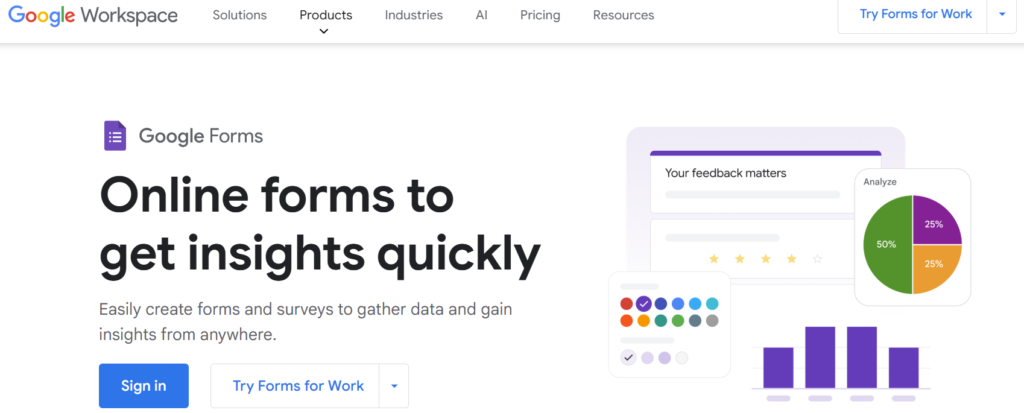
Key Features for Customer Training
Simple Form Builder: Easily create forms using common question types like multiple choice, checkboxes, dropdowns, short answer field, and paragraphs.
Post Training-Feedback Collection: Quickly build and distribute simple feedback forms for training sessions without investing in expensive alternatives.
Training Session Registration: Create straightforward registration forms to collect names, email addresses, and other customer details.
Collaboration & Communication Tools:
Collaboration and communication tools can be used to host live training sessions, but also interact on a one on one or group basis with your customers. They are flexible, easy to use, and can typically handle thousands of users participating at any one time.
18. Microsoft Teams
G2 Score
Overview
Microsoft Teams is a communication platform integrated within the Microsoft 365 suite. For customer training it can be used to host one on one training sessions, webinars, and large-scale online events.
The platform also supports file sharing, and private chat channels which can be used for specific customer communication scenarios.
Key Features and Uses for Customer Training
Live Virtual Workshops & Meetings: Host interactive training sessions where customers can participate using audio, video, and chat. Features like screen sharing, whiteboard, and breakout rooms help with collaborative learning.
Webinar Delivery: Host structured, presentation-focused training sessions for larger customer audiences, including features like attendee registration, moderated Q&A, polls, and presenter modes.
Large-Scale Broadcasts (Live Events): Use Teams Live Events for broadcasting training to very large customer audiences (thousands) and use it for product updates, or company-wide customer announcements.
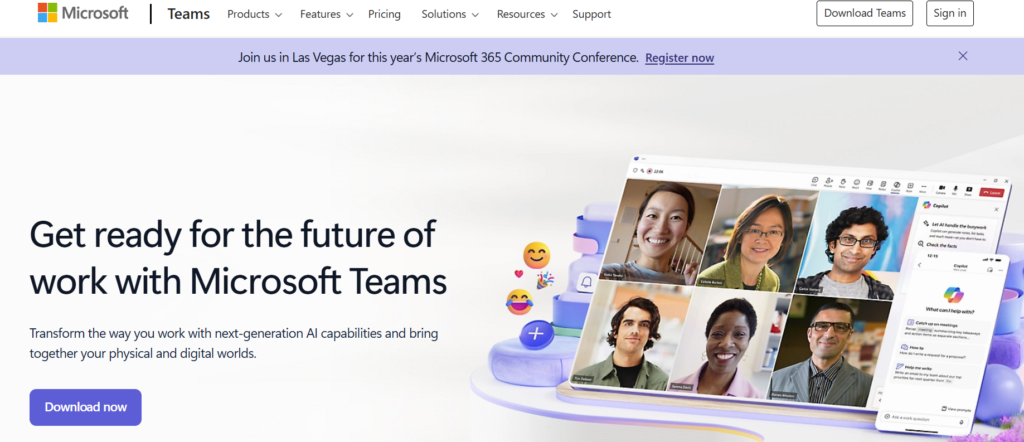
19. Slack
G2 Score
Overview
Slack, like Microsoft Teams, is a messaging and collaboration platform. For customer training features like Slack Connect enables communication between different organizations.
You can also split chats into different channels, allowing for more focussed conversations on specific topics between chosen participants.

Key Features and Uses for Customer Training
Dedicated Training Channels/Communities: Create specific Slack channels (public or private) for participants of a particular course, onboarding cohort, or for general product Q&A.
Announcements and Resource Sharing: Post updates about new training materials, courses, and reminders about upcoming live training sessions.
Asynchronous Q&A and Discussion: Use channels and threads to manage ongoing discussions related to training content, and set up channels for customers who have access to priority support.
Integrating Training Notifications: Integrate Slack with your wider tech stack using tools like Zapier, and get notified within the app when a certain event occurs, e.g., when you get a new sign-up to a course.
Content Creation & Design Tools:
Easy to use graphic design tools are where you can get creative! Use them to create any customer training material that needs to be appealing on the eye.
20. Canva
G2 Score
Overview
Canva is a hugely popular and user-friendly graphic design platform that aims to make creating and presenting visual content accessible to everyone. Inside Canva, you’ll find a vast library of customizable templates for various formats such as documents, presentations, social media posts, videos, web pages and more.

You’ll also find a wide library of stock photos, illustrations, icons, videos, and audio tracks. Key features include photo editing tools, brand kits, various export options, and generative AI tools to assist with content creation.
Uses for Customer Training
Designing presentation slides: Quickly create professional visually engaging slides for webinars, workshops or pre-recorded video training using thousands of customizable templates.
Creating training handouts & docs: Design well-formatted supporting materials like worksheets, checklists, start guides and more.
Produce simple videos and visual assets: Use Canva’s built-in video editor to combine video clips, stock footage, text overlays, animations, and voiceovers to create how-to videos and feature explainers.
Create custom graphics, icons, illustrations and more which can then be exported into an elearning authoring tool.
Project & Task Management Tools:
Last but not least are project & task management tools, which you’ll need for planning, and organizing the development of a customer training program: Trello, and Asana are two of the best to check out.
21. Trello
G2 Score
Overview
Trello is a flexible work management tool known for its simple Kanban-style interface based on boards, lists and cards.
A board typically represents a project or process, lists represent stages or categories within that process (e.g., “To Do,”, “In Progress,” “Done”), and Cards represent individual tasks or items that move across lists as they progress.
Cards can contain descriptions, checklists, due dates, labels attachments, and comments for collaboration.
Key Features and Uses for Customer Training
Managing Training Content Lifecycle & Resources:
Visualize Content Pipelines: Use Trello boards with lists representing stages e.g. ideas, drafting, review, published to track the creation of training assets,
Track Content Updates: Dedicate cards or lists to manage the review and update process for existing training materials, especially when triggered by product changes.
Organize Training Resources Visually: Set up boards to act as a visual directory where each card links to a specific training resource (help docs, videos recordings) using labels for easy filtering by topic or skill level.
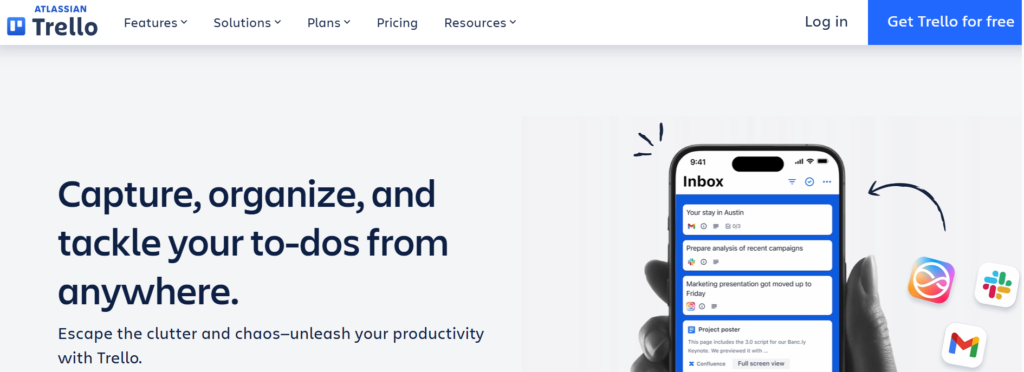
22. Asana
G2 Score
Overview
Asana is a popular work management platform, that you can use to organize, track and manage the processes involved with customer training.
Various use cases include coordinating the logistics of live training sessions, track customer progress through onboarding milestones, and manage the lifecycle of educational content.
Key Features for Customer Training
Projects, tasks and subtasks: used to break down large training initiatives (like course creation or onboarding programs) into manageable steps.
Assignees and due dates: to ensure clear ownership and timelines for projects.
Project templates: to standardize repeatable processes like creating new training modules or onboarding new customers.
Collaboration tools (comments, mentions, attachments): to enable training teams (instructional designers, CSMs, SMEs) to discuss specific tasks, share draft materials, and provide direct feedback.

Is There an All-In-One Tool for Customer Training?
The closest you can get to an all-in-one customer training tool is to look at an LMS or a training platform like Arlo. Using one of these platforms is typically the most efficient way to centralize some of the above in one central platform.
For example, Arlo, as we’ve looked at, has elearning authoring features, integrations with video tools like Zoom for virtual training, and integrations with tools such as SurveyMonkey for surveying and assessing their customer training.
Most of the LMS platforms we looked at also contain similar features. So, really the most efficient tech stack for customer training is to invest in:
- A training platform/LMS
- An onboarding/guided tour tool
- Software to create a knowledge base
- Collaboration, communication and project management tool to manage a customer training program.
If you want to get started with Arlo, and see how it can help you elevate your customer training, you can try out the platform with a 14-day trial below 👇
